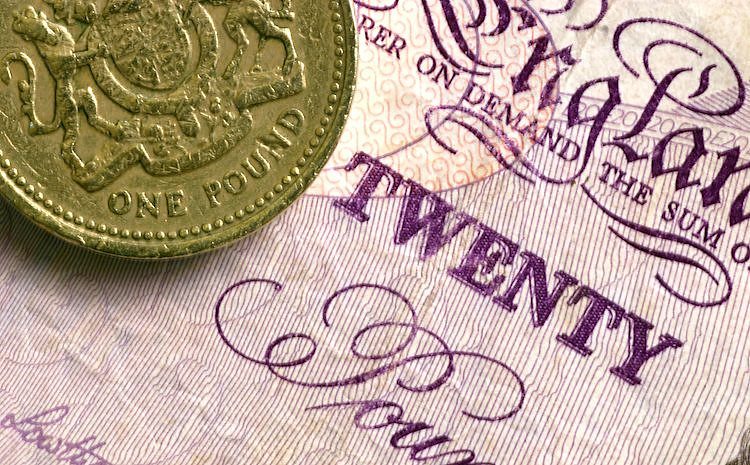Pound Sterling rebounds as fears of Middle East tensions escalating further ease
- The Pound Sterling finds cushion near 1.2400 after weak monthly UK Retail Sales data for March.
- Geopolitical fears and a strong outlook for the US Dollar keep the upside in the GBP/USD pair limited.
- Fed's Bostic said he is comfortable with interest rates remaining high.
The Pound Sterling (GBP) finds a temporary support near almost five-month low around 1.2400 against the US Dollar in Friday’s early American session. The US Dollar Index (DXY) struggles to sustain above the crucial support of 106.00 despite Federal Reserve (Fed) policymakers maintaining hawkish guidance on interest rates.
On Thursday, Atlanta Fed President Raphael Bostic said progress in inflation towards the 2% target will be slower than expected. Bostic also said he is comfortable with interest rates remaining high as labor demand is robust and wage growth remains resilient.
On the economic calendar front, the United Kingdom Retail Sales report for March has highlighted the consequences of higher interest rates. UK Retail Sales remained stagnant month-on-month as a decline in food and non-store retailing was offset by spending on fuel and non-food items.
Daily digest market movers: Pound Sterling rebounds as US Dollar edges down
- The Pound Sterling finds interim support near 1.2400 as reports from Iran showed that the drone attack at Isfahan was limited in size and has not resulted in any damage to nuclear facilities. Initially, reports came that Israel retaliated to Iran’s attack with drones in Friday’s early Asian session, Reuters reported citing several US officials. Iranian state media said that the air defense system brought down three drones over the central city of Isfahan.
- The near-term outlook of the Pound Sterling remains uncertain as the broader market mood remains risk-off amid fears of further escalation in the Middle East tensions and United Kingdom Retail Sales data for March failed to meet expectations.
- According to data from the country's Office for National Statistics, UK Retail Sales were unchanged in March compared with the previous month and less than the 0.3% increase forecasted by economists. In February, Retail Sales grew by a meagre 0.1%. On an annual basis, Retail Sales grew sharply by 0.8% after contracting by 0.3% in February.
- Retail Sales data indicate the current status of consumer spending, which accounts for a major part of economic growth. A stagnant performance on a month-on-month basis indicates that the BoE's high interest rates have significantly impacted consumer spending.
- Going forward, headlines surrounding the Middle East conflict and speculation about BoE rate cuts will guide the next move in the Pound Sterling. On the latter, markets currently anticipate the BoE starting to lower rates in November as March inflation data declined at a slower pace than estimated.
- On Thursday, BoE policymaker Megan Greene said in the Atlantic Council think tank in Washington: "The numbers that we're seeing in terms of wage growth and services inflation just aren't consistent with a sustainable 2% (consumer price) inflation target." When asked about a potential time frame for rate cuts, Greene said: "I don't think it's imminent."
Technical Analysis: Pound Sterling aims stability above 1.2400

The Pound Sterling refreshes an almost five-month low near 1.2400 against the US Dollar. The GBP/USD pair is expected to see more downside as the longer-term outlook is bearish. The asset remains below the 200-day Exponential Moving Average (EMA), which trades around 1.2560. The Cable experienced a sharp downside after a breakdown of the Head and Shoulder chart pattern formed on a daily time frame.
Adding to that, 14-period Relative Strength Index (RSI) oscillates inside the bearish range of between 20.00 and 40.00, suggesting momentum leans to the downside.
Risk sentiment FAQs
In the world of financial jargon the two widely used terms “risk-on” and “risk off'' refer to the level of risk that investors are willing to stomach during the period referenced. In a “risk-on” market, investors are optimistic about the future and more willing to buy risky assets. In a “risk-off” market investors start to ‘play it safe’ because they are worried about the future, and therefore buy less risky assets that are more certain of bringing a return, even if it is relatively modest.
Typically, during periods of “risk-on”, stock markets will rise, most commodities – except Gold – will also gain in value, since they benefit from a positive growth outlook. The currencies of nations that are heavy commodity exporters strengthen because of increased demand, and Cryptocurrencies rise. In a “risk-off” market, Bonds go up – especially major government Bonds – Gold shines, and safe-haven currencies such as the Japanese Yen, Swiss Franc and US Dollar all benefit.
The Australian Dollar (AUD), the Canadian Dollar (CAD), the New Zealand Dollar (NZD) and minor FX like the Ruble (RUB) and the South African Rand (ZAR), all tend to rise in markets that are “risk-on”. This is because the economies of these currencies are heavily reliant on commodity exports for growth, and commodities tend to rise in price during risk-on periods. This is because investors foresee greater demand for raw materials in the future due to heightened economic activity.
The major currencies that tend to rise during periods of “risk-off” are the US Dollar (USD), the Japanese Yen (JPY) and the Swiss Franc (CHF). The US Dollar, because it is the world’s reserve currency, and because in times of crisis investors buy US government debt, which is seen as safe because the largest economy in the world is unlikely to default. The Yen, from increased demand for Japanese government bonds, because a high proportion are held by domestic investors who are unlikely to dump them – even in a crisis. The Swiss Franc, because strict Swiss banking laws offer investors enhanced capital protection.
Forex News
Keep up with the financial markets, know what's happening and what is affecting the markets with our latest market updates. Analyze market movers, trends and build your trading strategies accordingly.
